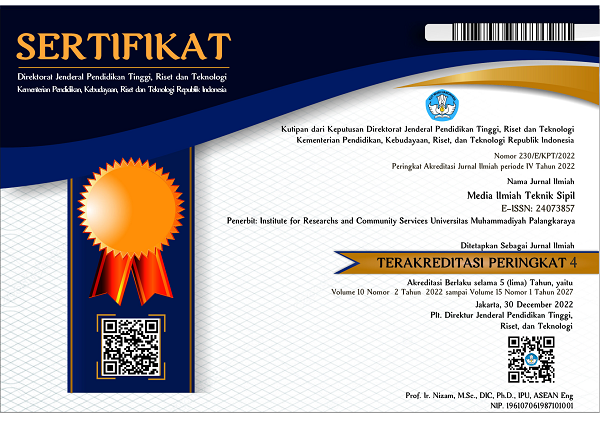Pengaruh Kekuatan Balok Induk Terhadap Dimensi Balok Anak Pada Beton Bertulang
The Effect of Primary Beam Strength on the Dimension of Secondary Beam on Reinforced Concrete
DOI:
https://doi.org/10.33084/mits.v8i1.1131Keywords:
Beton mutu normal, Beban maksimum, Deformasi, Tipe balok induk dan balok anakAbstract
Generally, concrete can be categorized into normal quality concrete and high-quality concrete, both are commonly used in construction. Normal quality concrete has approximately 20 MPa to 58 MPa quality, while the high-quality concrete has higher than 58 MPa. One of the applications of these concrete in structure is the dimension and joist position toward the beam’s strength in a story structure. To analyze the effect of joist toward beam, Finite Element Analysis (FEA)is applied with the following: Utilizing ANSYS with SOLID65, SOLID45, LINK8 with varying size of joist and beam such as type A beam by the size of 30/40 and joist by the size of 20/40, 25/40, 30/40, type B beam by the size of 30/50 and joist size of 25/50, 25/40, 25/35 and type C beam by the size of 40/60 and the joist size of 35/60, 35/50, 35/40. Steel material is used each has 400 MPa for the main reinforcement tension, 200 MPa for the stirrup reinforcement, normal quality concrete tension of 25 MPa, placement tension of 400 MPa, steel modulus elasticity of 200,000 MPa. Based on the FEA it is obtained that the comparison of joist influence toward the beam is centered from the comparison result of
Downloads
References
ANSYS Release 11. (2007). Programmer's Manual for ANSYS. ANSYS Incorporations and ANSYS Europe, Ltd. (http://ansys.com diakses tanggal 5 September 2009).
Chu-Kia Wang Charles G.Salmon Reinforced Concrete Design, Fourth Edition.
Ese Soedarsono HS, Design and Detailing of Flat Slab, 27 February 2002.
Jack C. Mc Cormac. Desain Beton Bertulang Edisi Kelima Jilid 2 Penerbit Erlangga Jakarta.
Kodur, V.K.R. Bisby, L.A. Evaluation of Fire Endurance of Concrete Slabs Reinforced With FRP Bars. Journal of Structural Engineering. ASCE. 131 (1). 2005. Pp 34-43 (http://link.aip.org diakses tanggal 4 Agustus 2009).
Mac Gregor, J. G. (1997). Reinforced Concrete: Mechanics and Design 3rd Ed. Prentice-Hall International, Inc.
http://www.gussuta.com/teknik/perpustakaan-teknik-sipil.html
Matsui. (1997). Tinjauan perilaku tegangan lekat pada struktur beton bertulang dengan Metode Semi Beam dan Pull Out.
Neville, A. Aitcin, P. C. High Performance Concrete-an overview Journal of Material and Structure. 31 March 1998. pp 111-117.
Parvanova, Sonia. L., et al. (2004). Modeling The Nonlinear Behaviour of R/C Beams With Moderate Shear Span and Without Strirrups Using Ansys.National Scienc Fund.Bulgaria
Purwono, R. (2005). Tata Cara Perhitungan Struktur Beton Bertulang Tahan Gempa (SN103-1726-2002). Edisi ketiga ITS Press. Surabaya. Indonesia
Purwono, R. Tavio,Iswandi I, I.Gusti Putu R. Tata Cara Perhitungan Struktur Beton Untuk Bangunan Gedung. (SNI 03-2847-2002) Dilengkapi Penjelasan [S-2002]. ITS Press. Surabaya. Indonesia
R. Park, W. L. Gamble. (1993). Reinforced Concrete Slabs
Shah, S. P. Ahmad, S.H. (1994). High Performance Concrete: Properties and Applications. Mc Graw-Hill Companies, (http://linkinghub.elsevier.com diakses Tanggal 4 Agustus 2009)
Downloads
Published
How to Cite
Issue
Section
License
All rights reserved. This publication may be reproduced, stored in a retrieval system, or transmitted in any form or by any means, electronic, mechanical, photocopying, recording.







